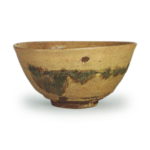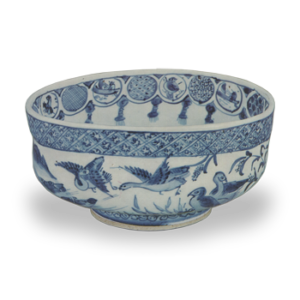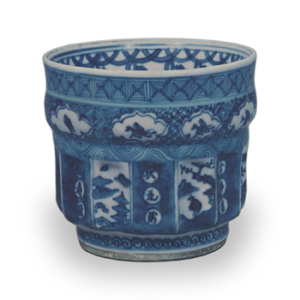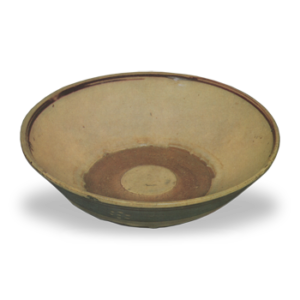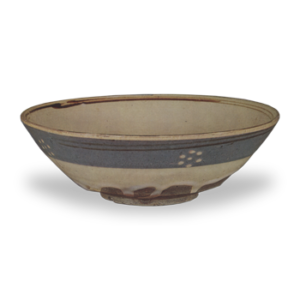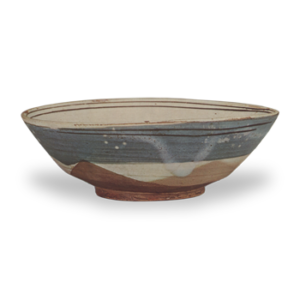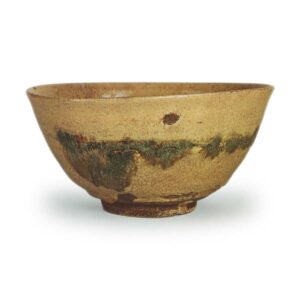
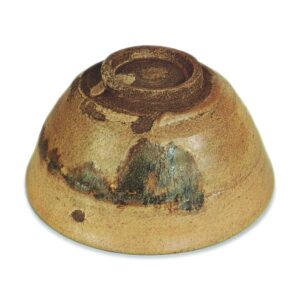
Choko specialty
Collection: Goto Museum of Art
Height: 7.5-7.8cm
Diameter: 15.2-15.8cm
Outer diameter of foot: 5.8-5.9cm
Height: 0.6cm
It is said that the name Haku-an originated from a tea bowl owned by Soya Haku-an (who died in December 1667 at the age of 62), who served as a physician for the shogunate in the early Edo period. There are more than ten tea bowls that have the same shape and style as the tea bowl owned by Haku-an, and they have been highly prized since ancient times. Half of these are now lost, and the ones that are known today include the so-called Honka (original tea bowl), as well as tea bowls with the names of their original owners, such as Fuyuki, Toki, Sakai, Okuda, Tennojiya, and Sosen, and one unmarked tea bowl.
The Haku-an tea bowl with the “Kuchiki” signature is one of these, and, alongside the original works and the “Fuyuki”, “Okuda” and “Toki” bowls, it is listed as a so-called “rejuvenated famous tea bowl” selected by Kobori Enshu. It was owned by Kutsuki Iyo no Kami (who was transferred to Fukuchiyama in Tanba in 1632 and died in 1714 at the age of 72), and so it bears this inscription.
The Hakuan ware has a number of common features, including the so-called ten vows: the color of loquat, the nakago glaze, the pattern of stains, the thin, flat foot ring, the creases on the back of the foot ring, the marks left by the potter’s wheel, the color of the residue from the unrefined clay, the tea pool, the small knob, the slightly curved rim, the foot ring with a pattern resembling a bamboo joint, and the splash glaze on the back of the foot ring. (the color of the squeezed lees of tofu), tea stains, small knobs, slightly curved rims, and the knobby foot ring and the flying glaze on the underside of the foot ring, etc. This tea bowl with the Kuchiki name also has all of these features. The loquat-colored glaze that covers the inside and outside of the bowl is particularly beautiful, and the glaze on the inside, which has a grayish-white speckled pattern, is particularly vivid with a deep luster. The coloring of the nakago glaze that appears on the horizontal gutter that runs around the center of the exterior body is also perfect, and the glaze surface widens on the left and then narrows as it turns to the right. There are three places where the glaze has broken, probably due to the fingers of the person holding the bowl when it was being glazed, near the border between the glaze and the exposed clay at the rim of the foot. In addition, this bowl is larger than other Haku-an tea bowls, and this is one of its features.
In addition to the inner box with wisteria-patterned maki-e lacquer and the middle box with plain maki-e lacquer, there is also an outer box with Shunkei lacquer, on which is written in the handwriting of the 447th abbot of the Daitoku-ji temple, Sessou (who died in 1869), “Kise-do tea bowl Haku-an” (on the lid) and “Nanmeian Muyo-ko (signature)” (on the underside of the lid). In addition, there is a piece of paper on the inside of the box that also bears the name “Haku-an”, but the writer is unknown. Also included are two letters from Funakoshi Iyomori, who praised this tea bowl, addressed to Sakai Kii-no-kami.
The bowl passed from the Kuchiki family to Shozaburo Fukae, then to the Mitsui family in Kyoto, the Konoike family in Osaka, and then to the Fujita family.
Shozaburo Fukae was a senior official in the Edo Ginza district, and he and other officials such as Nakamura Uchikousuke were appointed as the official tea taster in 1714. It is recorded in “Kokin Chawa” by Kanamori Tokusui that two Haku-an tea bowls were sold at auction from his private collection. According to the book, one was bought by Hiroshimaya Heijuro for 15 kan 377 monme, and the other by Iseya Yahei for 14 kan 97 monme 9 bu, but it is unclear which one was delivered to the Mitsui family.

